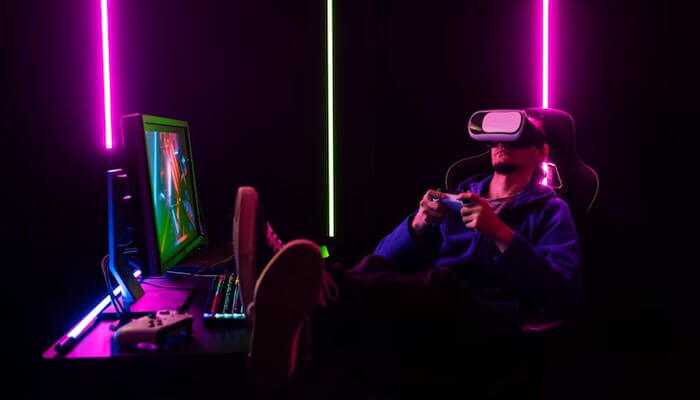Introduction
Esports has come a long way from a small niche subculture to a global phenomenon that has attracted millions of viewers and players around the world. As technology advances, eSports is changing for the better. Innovations such as VR and AR are playing a major role in shaping the future of esports. Let’s take a look at how these technologies are changing the gaming landscape.
Virtual Reality (VR) in the Future of Esports:
VR has revolutionized the esports industry by giving fans and players an unprecedented level of immersion. With the help of VR goggles, gamers can dive into the virtual world as if they were there and experience it with their own eyes.
Esports games designed in particular for virtual reality technology offer a fantastic level of immersion, enabling players to completely immerse themselves in the game world. By seamlessly integrating VR mechanics, players can actively explore their surroundings, interact with various factors inside the sports environment, and communicate more effectively with their teammates through superior interactive capabilities, fostering a heightened level of teamwork and strategic coordination at some stage in intense gaming sessions.
Virtual reality (VR) has the ability to revolutionize the way people interact with esports events by providing an unparalleled level of immersion. By providing viewers with 360-degree views of the gaming action, virtual reality live-streaming complements the overall experience, blurring the boundaries between the digital realm and reality. Fans are transported from their living rooms directly into the heart of the tournaments, making them experience like they are physically present at the event. This level of virtual immersion now not only elevates the viewing revel but additionally allows to bridge the distance between the digital and real worlds, creating a dynamic and interactive environment for spectators and players alike, thereby shaping the future of esports and gaming as a whole.
Enhancing real-world integration using augmented reality (AR):
Augmented Reality, an innovative technology that blends virtual factors with the actual world, offers promising opportunities inside the realm of esports. By integrating digital aspects seamlessly with physical surroundings, AR holds the capacity to revolutionize how gamers interact with their environment for the duration of esports events. One exciting possibility is the incorporation of interactive overlays on live broadcasts, providing visitors with real-time insights, unique participant profiles, and dynamic visual representations on their screens. This immersive experience not only enhances the overall excitement of esports competitions but also creates a new level of engagement among the game and its audience, paving the way for a more interactive and visually captivating future for the esports industry.
AR has incredible potential not only to enhance the training and coaching aspects of the esports industry but also to revolutionize the overall experience for spectators. Imagine players utilizing AR to visualize holographic representations of game scenarios seamlessly integrated into their real-world environment. This innovation could significantly elevate strategic preparation and analysis, offering players a deeper understanding of the game dynamics and allowing for more in-depth tactical insights. Such advancements in AR technology hold immense promise for the future evolution of esports.
Data Analytics and Performance Metrics Improvements:
Technology plays a crucial role in enhancing the analytical elements of esports. By leveraging current data analytics tools, the enterprise can delve into participants’ overall performance metrics, identify trends efficiently, and develop strong techniques based on insightful styles. This development indicates a shift towards more data-driven approaches in shaping the aggressive landscape of esports.
This data-driven strategy benefits not only the best character players but also the wider growth and competitiveness of esports on various levels. By integrating advanced technology like VR and AR into the evaluation of gaming data, players can gain a better understanding of their performance, leading to a more engaging and competitive esports landscape overall. Such immersive technologies no longer simply decorate the analytical process but also pave the way for innovative strategies and tactics to be advanced, ultimately contributing to the evolution and achievement of esports as a whole.
Breaking Down Barriers with VR and AR in the Future of Esports
In summary:
The combination of technological improvements with the world of esports has been a riding force propelling the industry to new heights. This collaboration now not only advances the sector but additionally opens up a myriad of fresh avenues for not handiest the ones actively participating in esports but also for the viewers and key players in the enterprise. It is actually a transformative juncture that is reshaping how people interact with esports, blurring the lines between virtual and reality through the seamless integration of cutting-edge technologies like virtual reality and augmented reality. This evolution is paving the manner for an immersive and dynamic experience that transcends traditional boundaries and gives a whole new size to the world of competitive gaming.
The evolution of esports activities holds the promise of supplying fans throughout the globe with increasingly more immersive, pleasant, and captivating reviews as improvements in technology continue to unfold. As we assignment into the uncharted territory that lies in advance, it becomes evident that the possibilities rising at the intersection of esports and technology are giant and hold amazing capability for reshaping the way enthusiasts engage with their favorite aggressive gaming endeavors. The unexplored path we are embarking on gives a glimpse right into a future wherein the synergy between esports and cutting-edge technology opens up a world of fresh opportunities and exciting horizons waiting to be embraced.



